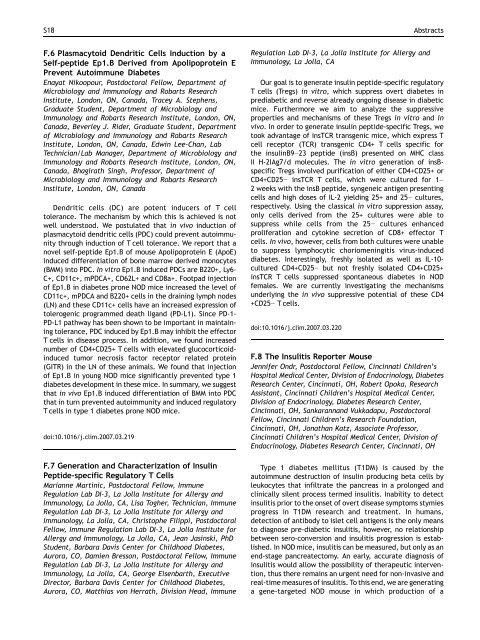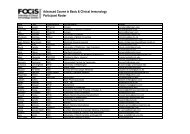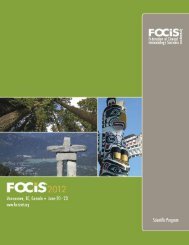Oral Presentations - Federation of Clinical Immunology Societies
Oral Presentations - Federation of Clinical Immunology Societies
Oral Presentations - Federation of Clinical Immunology Societies
Create successful ePaper yourself
Turn your PDF publications into a flip-book with our unique Google optimized e-Paper software.
S18 Abstracts<br />
F.6 Plasmacytoid Dendritic Cells Induction by a<br />
Self-peptide Ep1.B Derived from Apolipoprotein E<br />
Prevent Autoimmune Diabetes<br />
Enayat Nikoopour, Postdoctoral Fellow, Department <strong>of</strong><br />
Microbiology and <strong>Immunology</strong> and Robarts Research<br />
Institute, London, ON, Canada, Tracey A. Stephens,<br />
Graduate Student, Department <strong>of</strong> Microbiology and<br />
<strong>Immunology</strong> and Robarts Research Institute, London, ON,<br />
Canada, Beverley J. Rider, Graduate Student, Department<br />
<strong>of</strong> Microbiology and <strong>Immunology</strong> and Robarts Research<br />
Institute, London, ON, Canada, Edwin Lee-Chan, Lab<br />
Technician/Lab Manager, Department <strong>of</strong> Microbiology and<br />
<strong>Immunology</strong> and Robarts Research Institute, London, ON,<br />
Canada, Bhagirath Singh, Pr<strong>of</strong>essor, Department <strong>of</strong><br />
Microbiology and <strong>Immunology</strong> and Robarts Research<br />
Institute, London, ON, Canada<br />
Dendritic cells (DC) are potent inducers <strong>of</strong> T cell<br />
tolerance. The mechanism by which this is achieved is not<br />
well understood. We postulated that in vivo induction <strong>of</strong><br />
plasmacytoid dendritic cells (PDC) could prevent autoimmunity<br />
through induction <strong>of</strong> T cell tolerance. We report that a<br />
novel self-peptide Ep1.B <strong>of</strong> mouse Apolipoprotein E (ApoE)<br />
induced differentiation <strong>of</strong> bone marrow derived monocytes<br />
(BMM) into PDC. In vitro Ep1.B induced PDCs are B220+, Ly6-<br />
C+, CD11c+, mPDCA+, CD62L+ and CD8a+. Footpad injection<br />
<strong>of</strong> Ep1.B in diabetes prone NOD mice increased the level <strong>of</strong><br />
CD11c+, mPDCA and B220+ cells in the draining lymph nodes<br />
(LN) and these CD11c+ cells have an increased expression <strong>of</strong><br />
tolerogenic programmed death ligand (PD-L1). Since PD-1-<br />
PD-L1 pathway has been shown to be important in maintaining<br />
tolerance, PDC induced by Ep1.B may inhibit the effector<br />
T cells in disease process. In addition, we found increased<br />
number <strong>of</strong> CD4+CD25+ T cells with elevated glucocorticoidinduced<br />
tumor necrosis factor receptor related protein<br />
(GITR) in the LN <strong>of</strong> these animals. We found that injection<br />
<strong>of</strong> Ep1.B in young NOD mice significantly prevented type 1<br />
diabetes development in these mice. In summary, we suggest<br />
that in vivo Ep1.B induced differentiation <strong>of</strong> BMM into PDC<br />
that in turn prevented autoimmunity and induced regulatory<br />
T cells in type 1 diabetes prone NOD mice.<br />
doi:10.1016/j.clim.2007.03.219<br />
F.7 Generation and Characterization <strong>of</strong> Insulin<br />
Peptide-specific Regulatory T Cells<br />
Marianne Martinic, Postdoctoral Fellow, Immune<br />
Regulation Lab DI-3, La Jolla Institute for Allergy and<br />
<strong>Immunology</strong>, La Jolla, CA, Lisa Togher, Technician, Immune<br />
Regulation Lab DI-3, La Jolla Institute for Allergy and<br />
<strong>Immunology</strong>, La Jolla, CA, Christophe Filippi, Postdoctoral<br />
Fellow, Immune Regulation Lab DI-3, La Jolla Institute for<br />
Allergy and <strong>Immunology</strong>, La Jolla, CA, Jean Jasinski, PhD<br />
Student, Barbara Davis Center for Childhood Diabetes,<br />
Aurora, CO, Damien Bresson, Postdoctoral Fellow, Immune<br />
Regulation Lab DI-3, La Jolla Institute for Allergy and<br />
<strong>Immunology</strong>, La Jolla, CA, George Eisenbarth, Executive<br />
Director, Barbara Davis Center for Childhood Diabetes,<br />
Aurora, CO, Matthias von Herrath, Division Head, Immune<br />
Regulation Lab DI-3, La Jolla Institute for Allergy and<br />
<strong>Immunology</strong>, La Jolla, CA<br />
Our goal is to generate insulin peptide-specific regulatory<br />
T cells (Tregs) in vitro, which suppress overt diabetes in<br />
prediabetic and reverse already ongoing disease in diabetic<br />
mice. Furthermore we aim to analyze the suppressive<br />
properties and mechanisms <strong>of</strong> these Tregs in vitro and in<br />
vivo. In order to generate insulin peptide-specific Tregs, we<br />
took advantage <strong>of</strong> insTCR transgenic mice, which express T<br />
cell receptor (TCR) transgenic CD4+ T cells specific for<br />
the insulinB9–23 peptide (insB) presented on MHC class<br />
II H-2IAg7/d molecules. The in vitro generation <strong>of</strong> insBspecific<br />
Tregs involved purification <strong>of</strong> either CD4+CD25+ or<br />
CD4+CD25− insTCR T cells, which were cultured for 1–<br />
2 weeks with the insB peptide, syngeneic antigen presenting<br />
cells and high doses <strong>of</strong> IL-2 yielding 25+ and 25− cultures,<br />
respectively. Using the classical in vitro suppression assay,<br />
only cells derived from the 25+ cultures were able to<br />
suppress while cells from the 25− cultures enhanced<br />
proliferation and cytokine secretion <strong>of</strong> CD8+ effector T<br />
cells. In vivo, however, cells from both cultures were unable<br />
to suppress lymphocytic choriomeningitis virus-induced<br />
diabetes. Interestingly, freshly isolated as well as IL-10cultured<br />
CD4+CD25− but not freshly isolated CD4+CD25+<br />
insTCR T cells suppressed spontaneous diabetes in NOD<br />
females. We are currently investigating the mechanisms<br />
underlying the in vivo suppressive potential <strong>of</strong> these CD4<br />
+CD25− T cells.<br />
doi:10.1016/j.clim.2007.03.220<br />
F.8 The Insulitis Reporter Mouse<br />
Jennifer Ondr, Postdoctoral Fellow, Cincinnati Children’s<br />
Hospital Medical Center, Division <strong>of</strong> Endocrinology, Diabetes<br />
Research Center, Cincinnati, OH, Robert Opoka, Research<br />
Assistant, Cincinnati Children’s Hospital Medical Center,<br />
Division <strong>of</strong> Endocrinology, Diabetes Research Center,<br />
Cincinnati, OH, Sankarannand Vukkadapu, Postdoctoral<br />
Fellow, Cincinnati Children’s Research Foundation,<br />
Cincinnati, OH, Jonathan Katz, Associate Pr<strong>of</strong>essor,<br />
Cincinnati Children’s Hospital Medical Center, Division <strong>of</strong><br />
Endocrinology, Diabetes Research Center, Cincinnati, OH<br />
Type 1 diabetes mellitus (T1DM) is caused by the<br />
autoimmune destruction <strong>of</strong> insulin producing beta cells by<br />
leukocytes that infiltrate the pancreas in a prolonged and<br />
clinically silent process termed insulitis. Inability to detect<br />
insulitis prior to the onset <strong>of</strong> overt disease symptoms stymies<br />
progress in T1DM research and treatment. In humans,<br />
detection <strong>of</strong> antibody to islet cell antigens is the only means<br />
to diagnose pre-diabetic insulitis, however, no relationship<br />
between sero-conversion and insulitis progression is established.<br />
In NOD mice, insulitis can be measured, but only as an<br />
end-stage pancreatectomy. An early, accurate diagnosis <strong>of</strong><br />
insulitis would allow the possibility <strong>of</strong> therapeutic intervention,<br />
thus there remains an urgent need for non-invasive and<br />
real-time measures <strong>of</strong> insulitis. To this end, we are generating<br />
a gene-targeted NOD mouse in which production <strong>of</strong> a




